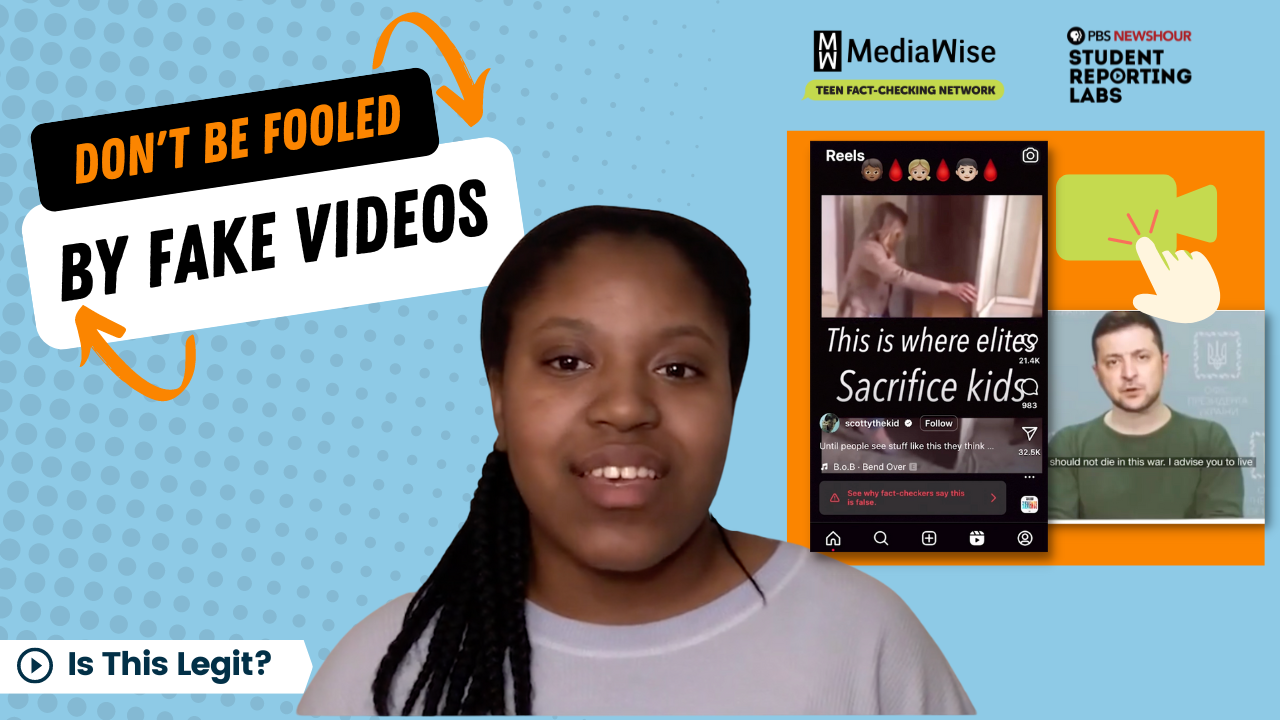False or misleading videos pop up a lot of ways online, like this one where an Instagram user posted a video of a woman revealing a hidden trap door leading to a secret underground theater.
“Until people see stuff like this, they think it’s a conspiracy. … The sooner people wake up to this, the sooner the nightmare is over,” the caption said.
According to the Instagram user, this place isn’t an innocent theater; it’s a place where “elites sacrifice kids.” Is the information they’re sharing about the theater true or is there more to the story?
Here’s how we fact-checked it.
Start with a keyword search
To fact-check this video, I started with a keyword search for “child sacrifice theater.” The goal when fact-checking is to start simple and quick; it might just be a few keywords. Several articles popped up in the results, including one from The Associated Press.
The AP is a trustworthy news organization, so I clicked on that one. It said that there’s more to the story than what the original user depicted on their social media page.
“The theater in the video is Teatro Donnafugata, a venue built inside a castle in Ragusa, Sicily, that hosts musical performances and plays,” the AP wrote.
And the secret entrance is nothing to be scared about. It’s used “to access the theater’s central boxes.”
Use a primary source
After a trusty keyword search, I found out most of what I wanted to know. But I didn’t stop there. I opened another tab and typed in the name of the theater, Teatro Donnafugata, and browsed its website. After reviewing pictures of the theater I compared it to the video and could confirm they were both the same venue.
Rating
Not Legit. The video posted by the user who made the claim that this is a location for “elites to sacrifice kids” was not edited or distorted in any way, but the information they shared about the video was false.
Spotting Misleading Videos
A MediaWise study found that more than a third of teens think they see misinformation online every day, and only 12% are totally confident they can spot falsehoods — like the video we just checked.
Misleading videos can appear in a variety of ways on the internet, and a Washington Post story breaks them down into three categories.
- The first is “missing context” — like the theater video. This type of footage is unaltered, but is accompanied by false information that misleads the viewer.
- The second is “deceptive editing” where footage is rearranged and edited, or some parts have been redacted.
- The third is “malicious transformation.” Think of deepfakes, when artificial intelligence is used to create fake images or audio. These videos are what the Post describes as being doctored or fabricated.
We’ve already looked at an out-of-context video. But what are some examples of deceptively edited videos or those that have been maliciously transformed?
A perfect example of deceptive editing is this video shared on Twitter of White House press secretary Karine Jean-Pierre abruptly leaving the press room after being questioned about classified documents in President Joe Biden’s possession. It looks like she is refusing to answer the reporter’s question.
To figure out if this was real, I did a keyword search for the phrase “transcripts of White House press briefings,” and I found this site, which has all the transcripts of every press briefing at the White House.
Going directly to a primary source is always your best bet for finding accurate information.
The date on the tweet said Jan. 11, so I scrolled down and found the transcript for that day. Next I used command+f and found the exact question from the reporter in the transcript.
After reviewing it, I verified that the press secretary actually provided a response and the clip of her walking out was at the end of the conference.
To understand the third type of doctored video, called malicious transformation, take a look at this video, which appears to show Ukraine president Volodymyr Zelenskyy commanding his troops to lay down their arms and surrender.
It went viral across Ukraine and hackers even put it on a Ukrainian news outlet.
This is an example of a deepfake — a video of a person in which their face or body has been digitally manipulated to make it look like they said or did something they didn’t.
This was not an especially sophisticated deepfake, according to NPR, and viewers quickly noticed that his accent was off and his head looked a little odd. But if you weren’t quick enough to pick up that this was a deepfake, it could have the potential to cause serious damage.
Some tips
Bottom line, it can be tough trying to figure out if videos online are digitally altered or if information surrounding certain footage is false.
But here are some tips to help you spot videos that might typically fool you:
- Always try to find the original source of the material. Use a keyword search and do some lateral reading to find out if the video has been altered before you believe what you’re watching.
- A video that seemingly has unexplainable, awkward gaps is suspicious and might have been edited.
- If you see a public figure doing something that seems exaggerated, unrealistic or not in character, it could be a deepfake.
NOTE TO TEACHERS: This article is featured in a free, one-hour lesson plan that teaches students about three types of deceptive videos and how to spot them. The lesson is available through PBS LearningMedia, and includes a lesson summary and a handout, among other resources.






